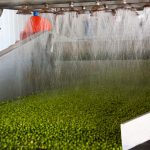
The Pomelo (Citrus grandis L. Osbeck or Citrus maxima Merr.) a.k.a. pummelo, shaddock, lusho fruit or Chinese grapefruit is not a fruit I’ve often encountered in the market place but it has much of the nutritional value of the more commonly encountered citrus fruits. It looks like a very large grapefruit to which it is closely botanically related to, with a greenish peel. It is widely grown in South-East Asia, especially in China, Malaysia, Japan and Thailand, the USA and other more tropical climes (Ladanya, 2008).
Cultivation And Varieties
Its cultivation and uses have been characterised (Morton, 1987). The fruit is classified according to pulp colour being either white (common) or pink (pigmented) (Sawamura et al., 1991. The well-known varieties are Banpeiyu, Kao-Tangkwa, Hirado Buntan, Tosa Buntan, Kao-Yai, Tubtim Siam, Thong-dee, Kao-Numpueng, and Ta-Koi.
The fruit juice has a sweet, slightly acidic, citrus-like aroma and flavour with some bitterness. Whilst cultivar differences are apparent, there are probably major flavour differences between the white and pink types.
Aldehydes which contribute much of the citrus notes are twofold higher in the pink version compared to the white (Perez-Cacho and Rouseff, 2008).
Aroma
The peel has potential as a food material as its normally discarded. The aroma of the peel was recently characterised using a variety of extraction techniques – cold pressing (CP), water distillation (WD), simultaneous distillation and extraction (SDE), microwave-assisted extraction (MAE), ultrasonic-assisted extraction (UAE) and supercritical CO2 fluid extraction (SFE) (Sun et al., 2014). Sensory evaluation and gas chromatography–mass spectrometry (GC-MS) analysis showed differences between the different types of extraction but generally the composition of the volatiles was:- limonene (301 476–497 028 µg/ml), β-myrcene (86 400–230 400 µg/ml), β-pinene (1370–7129 µg/ml), linalool (1916–4482 µg/ml) and germacrene D (1165–2327 µg/ml).
The main aroma compounds in pink pomelo peel based on gas chromatography-olfactory (GC-O) are:- trans-linalool oxide, cis,trans-2,6-nonadienal, octanal, citronellal, nonanal, trans-nerolidol, neryl acetate, indole, 6-methyl-5-hepten-2-one, terpinolene, trans-2-heptenal, perilla alcohol and nootkatone (Cheong et al., 2011).
The main aroma compounds in white pomelo peel using GC-O are:- terpinolene, α-copaene, 4-terpinenol, trans-nerolidol, trans-linalool oxide, nootkatone, cis,trans-2,6- nonadienal, citronellol, elemol, carvyl acetate, 6-methyl-5-hepten-2-one, perilla aldehyde and indole (Cheong et al., 2011).
Odour activity values (OAVs) and cluster analysis showed the SDE and WD aroma extracts were richer in fermented and overripe notes, with pungent and alcohol aromas. This was attributed mainly to larger amounts of nerol, neral and linalool oxide. Sweet notes from the SFE extract were due to citronellal and limonene oxide and may be an absence of nerol, neral and limonene (Sun et al., 2014).
The aroma of pummelo essential oil is readily destroyed by sunlight which produces an oily off-note (Sun et al., 2014b).
The peel contains a very high fibre content (upto 78%) (Ittimongkol et al., 2004) with 7 to 21% pectin (Norziah et al., 2000; Chaidedgumjom et al., 2009).
Principal Bioactives In Pomelo
The main bioactives are furanocoumarins which are also found in grapefruit (Guo et al., 2000; Ohnishi et al., 2000) and which also gives it similar immune modulating properties. The pulp of the fruit has been recently investigated for its antioxidant, and lipid or fat reducing properties in blood (antihyperlipidemic) (Mäkynen et al., 2013). A GC-MS analysis of essential oil from its peel shows it to contain D-limonene (62.5%) , anethol (9.5%), nootkatone (5.6%), β-linalool (2.3%) and β- caryophyllene (2.3%) (Zhou et al., 2004).
For the product developer, I’d recommend trying it as a flavour for protein powders and high protein bars (>10g per serve) which require novelty where tropical notes are needed.
References
Chaidedgumjorn, A., Sotanaphun, U., Kitcharoen, N., Asavapichayont, P., Satiraphan, M. Sriamornsak, P. (2009). Pectins from Citrus maxima. Pharmaceutical Biology, 47 pp. 521-526
Cheong, M.W., Liu, S.Q., Zhou, W., Curran, P., Yu, B. (2012) Chemical composition and sensory profile of pomelo (Citrus grandis (L.) Osbeck) juice. Food Chem., 135 (4) pp. 1505-1513
Guo, L.Q., Fukuda, K., Ohta, T., and Yamazoe, Y. (2000) Role of furanocoumarin derivatives on grapefruit juice-mediated inhibition of human CYP 3A activity. Drug Metab Dispos 28: pp. 766-771.
Ittimongkol, B., Srisukh, V., Nitibhon, M. & Saraya, S. (2004). Fiber-supplemented tablets from pomelo rind. Ind. J. Pharmaceutical Sci., 6 pp. 53-59
Ladaniya, M.S. (2008) Commercial fresh citrus cultivars and producing countries. In: Ladaniya, M.S., editor. Citrus fruit. San Diego: Academic Press. p 13–65.
Morton, J. F. (1987). Pummelo. In: Fruits of warm climates. Miami, FL: Floride Flair Books. pp. 147–151
Norziah, M.H., Fang, E.O., Karim, A. (2000). Extraction and characterisation of pectin from pomelo fruit peels. In: Gums and Stabilizers for the Food Industry (Edt. P.A. Williams) Cambridge, UK: Royal Society of Chemistry. pp, 27-36
Ohnishi, A., Matsuo, H., Yamada, S., Takanaga, H., Morimoto, S., Shoyama, Y., Ohtani, H., and Sawada, Y. (2000) Effect of furanocoumarin derivatives in grapefruit juice on the uptake of vinblastine by Caco-2 cells and on the activity of cytochrome P450 3A4. Br J Pharmacol 130 pp. 1369-1377.
Perez-Cacho, P. R., and Rouseff, R. L. (2008). Fresh squeezed orange juice odor: A review. Crit. Rev. in Food Science and Nutrition, 48(7),pp. 681–695.
Sawamura, M., Shichiri, K., Ootani, Y., & Zheng, X. H. (1991). Volatile constituents of several varieties of pomelos and characteristics among citrus species. Agric. Biol. Chem., 55(10), pp. 2571–2578.
Sun H., , , , and (2014a) Sensory evaluation and gas chromatography–mass spectrometry (GC-MS) analysis of the volatile extracts of pummelo (Citrus maxima) peel. Flavour Fragr. J., 29, pp. 305–312, doi: 10.1002/ffj.3206
Zhou, Y.-H., H.-Y, Qiao, Wang, L.-S., Liu, X.-M. (2004) GC-MS analysis of essential oil from pomelo peel obtained in Rong country. J. Guangxi Univ. (Nat. Science edt.) 2004-01


Leave a Reply